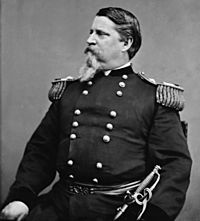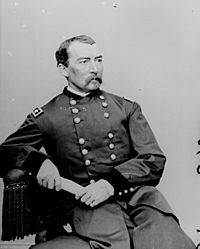Fort Harker (Kansas) facts for kids
Quick facts for kids Fort Harker |
|
|---|---|

Fort Harker guardhouse (2014)
|
|
| Location | Kanopolis, Kansas, USA |
| Built | 1866-1867 |
| Lua error in Module:Location_map at line 420: attempt to index field 'wikibase' (a nil value). | |
Fort Harker was an important military base for the United States Army. It was located in Kanopolis, Kansas, and was active from November 17, 1866, until October 5, 1872. The fort was named after General Charles Garrison Harker. He was a brave soldier who died in the American Civil War during the Battle of Kennesaw Mountain.
Fort Harker took the place of an older base called Fort Ellsworth. The new fort was built about 1.6 kilometers (1 mile) away. Fort Harker became a very important place for sending supplies to other military posts further west. It was one of the most crucial army stations west of the Missouri River.
Contents
History of Fort Harker
Why Fort Harker Was Built
Fort Ellsworth was first set up in August 1864. It was located where two important trails met, near the Smoky Hill River. This fort was the main office for the army in the Upper Arkansas area. Soldiers there protected wagon trains traveling on the trails. They also made sure supplies reached other army bases further west.
Fort Ellsworth connected supply lines from Fort Leavenworth and Fort Riley in the east. It also linked to Fort Zarah, Fort Larned, Fort Dodge, Fort Hays, and Fort Wallace in the west. After two years, the fort had grown a lot. It needed better buildings and more space for its operations.
Building the New Fort
General Winfield S. Hancock ordered a new fort to be built on November 17, 1866. He was the commander of the Division of the Missouri. The new fort would be about 1.6 kilometers (1 mile) northeast of Fort Ellsworth. Workers might have started building even before the official order. Fort Ellsworth already had many skilled builders in September 1866.
Most of the new fort's buildings were likely finished by the summer of 1867. In June 1867, the old Fort Ellsworth buildings were taken down. The land was sold and became the town of Ellsworth, Kansas.
Soon after the fort was built, the railroad arrived. The Union Pacific Eastern Division finished its tracks to Fort Harker in July 1867. The train line went right through the fort, and a station was built nearby. Two large warehouses were built next to the tracks. These became the main way to bring supplies to the fort. By the end of 1867, Fort Harker had over 75 buildings. It also had a group of four army companies and a large supply depot.
The Cholera Outbreak of 1867
In the summer of 1867, a serious illness called Asiatic cholera spread at Fort Harker. It affected the soldiers of the 38th Infantry. They had traveled from St. Louis, Missouri, where cholera was also present. The first case at the fort was found on June 28.
Soon, soldiers and civilians at the fort, and even nearby settlers, became sick. Many people died from the disease. Records show that 58 citizens were buried in June alone. The outbreak continued through 1867. By the end of the year, 24 white soldiers and 22 black soldiers had died. Many more had gotten sick.
Battles and Campaigns
No battles were ever fought directly at Fort Harker. However, soldiers from the fort were part of the Indian Wars. These were conflicts between the United States Army and Native American tribes on the Great Plains. In 1867, troops from Fort Harker protected more wagon trains than any other fort after the Civil War.
Once the railroad arrived in 1867, the need for escorts moved further west. By 1868, Fort Harker's main job changed. It became a place to store supplies and gather troops. In the fall of 1868, General Philip Henry Sheridan moved his command center to Fort Harker. From there, he led campaigns against Native Americans during the winter of 1868-1869.
Other important military leaders also used Fort Harker. In August 1869, Colonel Joseph G. Tilford commanded two groups of General George Armstrong Custer's 7th Cavalry at the fort. They left for a campaign in February 1870. In May 1870, General Custer and the rest of the 7th Cavalry passed through Fort Harker. They were on their way to engage Native Americans further west.
Why Fort Harker Closed
By 1871, Fort Harker was not as important in the Indian Wars. White settlers had moved into the area, and the conflicts had shifted west. The growing railroad network also made the fort less important for distributing supplies.
In March 1872, the 15th Infantry soldiers at Fort Harker moved to Fort Union. On April 5, the remaining companies of the 5th Infantry also left. Official orders to close Fort Harker came on April 8, 1872. The last soldiers, from the 5th Cavalry, left on May 7. A small group of officers and soldiers stayed behind for a short time. The base was completely empty by October 5, 1872.
Where Fort Harker Was Located
Fort Harker was built where the town of Kanopolis, Kansas is today.
Fort Harker Museum
|
Fort Harker Guardhouse;
Fort Harker Officers' Quarters |
|

Fort Harker officers' quarters (2014)
|
|
| Location | East side of Colorado St along Ohio Ave, Kanopolis, Kansas, USA |
|---|---|
| Built | 1866-1867 |
| NRHP reference No. | 72000497; 74000834 |
| Added to NRHP | February 23, 1972; November 20, 1974 |
Today, the Ellsworth County Historical Society takes care of three of the original Fort Harker buildings. They are now a museum that tells the story of both Fort Ellsworth and Fort Harker. These buildings include the Fort Harker Guardhouse and the Fort Harker Commanding Officers' Quarters. Both of these are listed on the National Register of Historic Places. The museum also has a Junior Officer's Quarters and a train depot with exhibits about a salt mine and life in the late 1800s and early 1900s.
Another Junior Officer's Quarters building is now a private home.
See also
- Hodgden House Museum Complex, in Ellsworth, also operated as a museum by the Ellsworth County Historical Society



